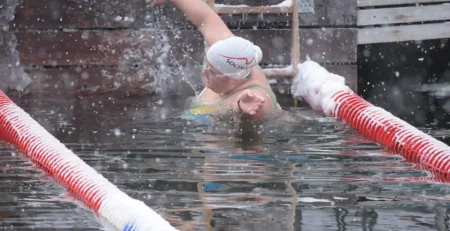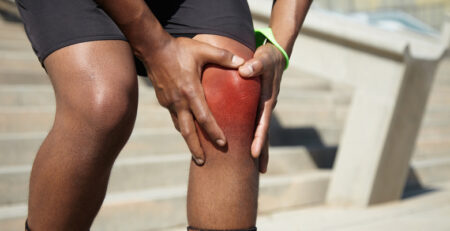Let’s be real — getting older or pushing your body hard in the gym comes with a not-so-fun side effect: joint pain. That dull ache in your knees when you climb the stairs, the stiffness in your shoulders after a workout, or that creaky morning feeling that makes you move like the Tin Man from the Wizard of Oz.
We’ve all heard the usual advice: take an anti-inflammatory, rest, and maybe apply a heating pad. But what if one of the most powerful tools for joint relief was actually the opposite of heat? What if it were submerging yourself in a freezing cold plunge?
Forget the generic wellness chatter. We’re going deep on one thing and one thing only: how cold water immersion actually influences the physiology of joint pain, from inflammation and nerve activity to cellular stress.. This isn’t just about “feeling better.” It’s about helping your joints reset and recover in ways most people overlook.
Table of Contents
The Root of the Ache: What’s Actually Happening in Your Joints?
To understand how a cold plunge helps, we first need to understand what we’re dealing with. Joint pain can come from several overlapping factors:
- Inflammation: This is the big one. When a joint is overused, injured, or affected by conditions like arthritis, the body’s immune response goes into overdrive. It sends extra blood and fluid to the area, causing swelling, stiffness, and pain. That swelling can even press on nearby nerves, making everything hurt more.
- Muscle Tension: Often, the muscles surrounding a painful joint will tighten up in a protective spasm. While meant to guard the joint, this tension can actually pull on it incorrectly, creating more pain in a vicious cycle.
- Nerve Sensitivity: Chronic pain can make the nerves in and around the joint hypersensitive. They start firing pain signals more easily, even with minimal movement or stimulus.
This is where the cold plunge steps in, not as a magic cure, but as a powerful biological reset button.
The Icy Trio: How Cold Plunges Tackle Joint Pain from Three Angles
When you lower yourself into an ice bathtub, your body reacts instantly. Three key mechanisms kick in to reduce joint pain and inflammation.
1. Vasoconstriction: The Body’s Natural Pressure Release
The moment your body hits the cold, your blood vessels near the skin and in the underlying tissues constrict tightly in a process called vasoconstriction.
This “squeeze” is like wringing out a sponge filled with inflammatory soup. It helps by physically pushing out excess fluid and swelling out of the joint capsule and the tissues surrounding it. Reducing this edema is a massive factor in relieving stiffness and pressure-related pain.
A study published in the European Journal of Applied Physiology noted that cold water immersion was effective at reducing swelling after intense exercise or injury — a key contributor to joint pain.
2. The Nervous System Reset: Numbing the Pain Signals
Cold is a powerful analgesic (pain blocker). Think of it as nature’s painkiller. When you plunge into icy water, the intense cold from the ice bath essentially overwhelms your nerve endings. It sends a massive “COLD!” signal to your brain, which temporarily blocks or overrides the smaller, constant “OUCH!” signals coming from your aching joint. This is known as the “gate control theory” of pain.
The result? It provides immediate, tangible relief. This numbing effect can break the cycle of pain, allowing you to move with less discomfort and reducing the muscle guarding we talked about earlier. Research into cold exposure for pain management, such as that reviewed in the Journal of Athletic Training, supports its role in pain reduction through neurogenic mechanisms. While the study focuses on concussion, it discusses cold therapy’s analgesic effects in a sports medicine context.
3. Lowering the Metabolic Rate
Cold slows everything down, including the metabolic activity of your cells. In an inflamed, painful joint, the cells are in a state of high stress and high activity, contributing to the inflammatory fire.
How this helps your joints: By slowing the metabolic rate of the tissues around the joint, cold plunging reduces their demand for oxygen and slows the production of those pro-inflammatory chemicals. It’s like turning down the thermostat on a raging fire, helping to calm the entire area and prevent further damage.
Cold Plunges and Arthritis: Can It Really Help?
This is where a lot of people get curious. If you live with osteoarthritis or rheumatoid arthritis, you’ve probably heard conflicting advice about whether to use heat or cold. While heat can feel good by relaxing muscles, cold exposure is often more effective at tackling the root inflammatory process.
For arthritic joints, which are often chronically inflamed and swollen, the vasoconstriction from a cold plunge is a direct counter-attack. Reducing that daily, low-grade swelling can lead to significant improvements in mobility and pain levels. A systematic review published in the Journal of Clinical Rheumatology concluded that cryotherapy (cold therapy) helps manage pain and inflammation in people with inflammatory rheumatic diseases, providing strong scientific backing for what many cold therapy advocates experience firsthand.
Of course, if you have a diagnosed condition like arthritis, always check with your doctor before starting any new treatment routine.
How to Use Cold Plunges for Joint Pain Relief
Cold plunging isn’t about just hopping into a random ice bath tub. To get the targeted relief for your joints, a little strategy goes a long way.
- Timing: The best time for a cold plunge for joint pain is after any activity that aggravates it, or as a general maintenance tool in the morning or evening. If your joints are stiff and achy when you wake up, a morning plunge can reduce stiffness. If they’re inflamed from the day’s activities, an evening plunge can help calm things down overnight.
- Cold plunge temperature: You don’t need a painfully cold bath to see benefits. A temperature between 50°F to 59°F (10°C to 15°C) is perfectly effective for targeting joint inflammation and pain without being unnecessarily brutal.
- Cold plunge duration: 10 to 15 minutes is the sweet spot. This is long enough to trigger the deep physiological benefits but short enough to be safe for most people. Listen to your body—if you’re shivering uncontrollably, it’s time to get out.
- Consistency is Key: While one ice bath can provide immediate relief, the most significant benefits for chronic joint pain come from regular practice. Making cold water immersion a consistent part of your routine helps manage inflammation levels over the long term. Learn about how often you should take a cold plunge.
The Cold Plunge Verdict on Joint Pain
So, is plunging into an ice bath tub the ultimate solution for all joint pain? Not exactly a miracle, but it is an incredibly powerful, drug-free tool backed by solid physiology.
By directly reducing inflammation through vasoconstriction, resetting your nervous system’s pain volume, and slowing down metabolic chaos, cold water immersion offers a unique form of relief that heat and rest alone often can’t match.
It’s about giving your joints a break from the constant pressure and irritation, allowing you to move more freely and with less pain. So, the next time your knees or shoulders are talking to you, maybe it’s time to listen—and then tell them to take the plunge.












Leave a Reply